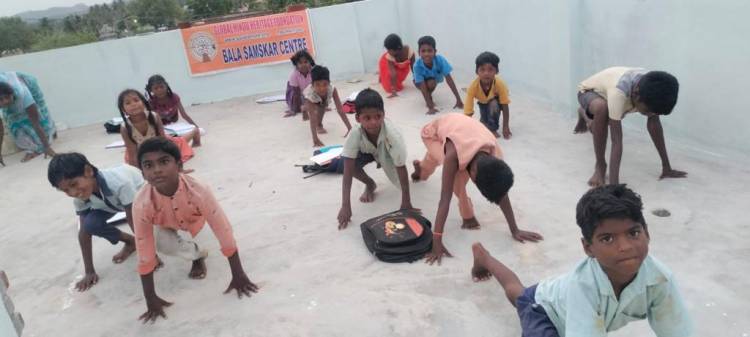[GHHF] Bala Samskar Kendra Students practiced Yoga as a part pf celebration of the International Day of Yoga.
 Swami Vivekananda:
Swami Vivekananda:
“Yoga is the science by which we may stop Chitta from assuming or becoming transformed into several faculties. As the reflection of the moon on the sea is broken or blurred by the waves, so is the reflection of the Atman, the true Self, broken by the mental waves. Only when the sea is stilled to mirror like calmness, can the reflection of the moon be seen, and only when the “mind-stuff,” the Chitta, is controlled to absolute calmness, is the Self to be recognized.”
Global Hindu Heritage Foundation has initiated Bala Samskar Kendras to enrich them with the richness of Hinduism. As part of our curriculum, we require all the students to practice Surya Namaskar to enable them to live a peaceful and stress-free life and also excel in their personal and professional life.
India’s Prime Minister Narendra Modi during his address to UN General Assembly in September 2014, had asked world leaders to adopt an international Yoga Day, saying “Yoga embodies unity of mind and body; thought and action; restraint and fulfillment; harmony between man and nature; a holistic approach to health and wellbeing. Yoga is not just about exercise; it is a way to discover the sense of oneness with yourself, the world and the nature. ” On December 11, 2014, the 193-member UN General Assembly adopted a resolution by consensus, proclaiming June 21 as ‘International Day of Yoga’. The resolution was introduced by India’s Ambassador to the UN and had 175 UN members, including five permanent members of the UN Security Council, as co-sponsors.
World Health Organization has also urged its member countries to help their citizens reduce physical inactivity, which is among the top ten leading causes of death worldwide, and a key risk factor for non-communicable diseases, such as cardiovascular diseases, cancer and diabetes. In fact, many Universities and Medical Hospitals have been conducting research and publishing voluminous amounts of research on the effects of the physical and mental well-being of the people. UNICEF recommends that kids can practice many yoga poses without any risk and get the same benefits that adults do. These benefits include increased flexibility and fitness, mindfulness, and relaxation.
Yoga was introduced because of its very nature to relax the mind, reduce the stress, boost the immune system, and improve the health benefits. Coronavirus has disrupted the routine life, curbed the movements, forced people to maintain social distance, required some people to maintain physical isolation, compelled people to work at home, cancel almost all air travel and restricted the movements causing more stress, anxiety, restlessness, agitation, irritation, and tension. Yoga comes to the rescue for those who take this rare opportunity to practice it, experience it and benefit from it.
School Yoga
Jessica Mei Gershen, a certified yoga instructor who teaches yoga to children at Brooklyn Yoga Project and founder of Yoga for All Needs, recommends making yoga playful and fun for kids, whether in the classroom or at home. In her yoga classes, Gershen weaves in fun games and stories with positive themes like compassion, gratitude, and strength.
“Yoga is really effective because it’s so tangible. Learning physical postures builds confidence and strength as well as the mind-body connection,” Gershen says. She also has found that the effects of yoga go beyond physical fitness and also allow kids to build confidence and awareness beyond the classroom. “Through yoga, kids start to realize that they are strong and then are able to take that strength, confidence, acceptance, and compassion out into the world,” notes Gershen.
Yoga will help the youth to improve fitness and physical health, reduce stress and anxiety, improve optimism, improve focus, and school performance, improve self-esteem and body image, encourage creativity, improved attention span, improved memory, overall academic improvement, and develop discipline and self-regulation,
“If you practice yoga every day with perseverance, you will be able to face the turmoil of life with steadiness and maturity” Iyengar BKS. Similarly, Sadhguru Vasudev says, “Yoga means to be in perfect tune. Your body, mind and spirit and the existence are in absolute harmony. When you fine-tune yourself to a point where everything functions so beautifully within you, the best of your abilities will naturally flow out of you.”
In a recent book on yoga education in India, A. Balkrishna claims that “in a nutshell, yoga is a powerful medium for developing the personality of children and making them capable of facing the present-day challenges and problems” [p. 3]. In her review article, “Effect of Yoga on Mental Health in Children,” one of the world’s most prominent yoga researchers, Shirley Telles, concludes that yoga improves children’s physical and mental well-being . Similarly, the Harvard professor Sat Bir Khalsa finds that yoga in schools helps students improve resilience, mood, and self-regulation skills pertaining to emotions and stress. Thus, yoga is an important life skill tool for children and young people to cope with stress and self-regulation from a life-long perspective.
Research has concluded that Yoga's impact on physical and mental health has been established in ancient Indian literature as well as contemporary yoga literature. It appears that yoga would help you to develop self-esteem, self-disciple, self -development and self-reflection.
“Yoga means balance, harmony and unity. Universal balance, Harmony of body, mind and soul and Unity of the individual consciousness with the cosmic consciousness. The ancient science of Yoga readily equips humans to reinstate world peace, environmental sustainability, as well as harmony between individuals, communities, religions, and nations. In modern times, Yoga has unfortunately come to mean only physical exercise or posture, however that is only one aspect of this ancient science, the others are neglected.” Swami Mahesharananda
Yoga for the Special Child, developed by Sonia Sumar, is designed to enhance the natural development of children with disabilities. The gentle and therapeutic style of yoga can be used for both babies and children with disabilities. Yoga for the Special Child incorporates yoga poses to increase flexibility and strength with breathing and relaxation techniques to increase focus and reduce hyperactivity.
A healthy body and mind are important for the development of all children. At all grade levels, from preschool through high school, students have shown improved academic and behavioral performance when yoga has been introduced in the school. The Association for School Yoga and Mindfulness continues to advocate for the inclusion of students with disabilities in school yoga programs, emphasizing, once again, that physical activity (yoga, in this case) is for everybody.
DONATIONS
PayPal Method: To donate visit our website: savetemples.org. Click on the Donate button, then press the Purpose category, and select the General Donation category.
By Check: Or you can send a check payable to: GHHF . It is tax-deductible.
By Zelle: ghhfusaorg@gmail.com
By Rupees, please contact us by either phone or email.
For more information, call Prakasarao V Velagapudi (601-918-7111) ; Email: ghhfusaorg@gmail.com






















 Urgent support needed for Bangladesh Hindus
Urgent support needed for Bangladesh Hindus 







